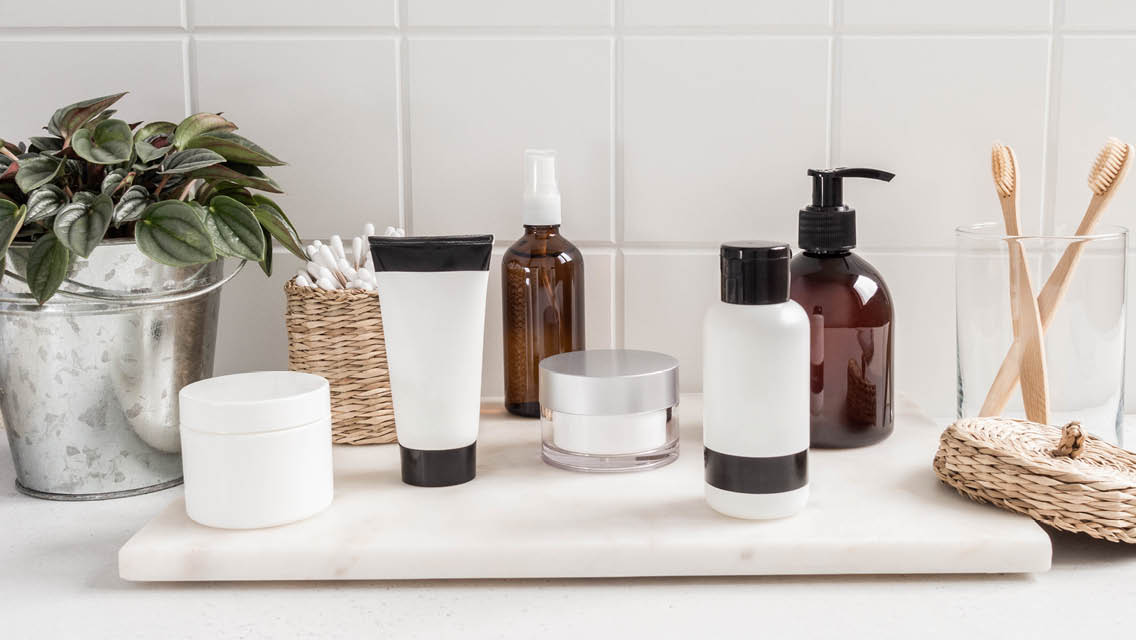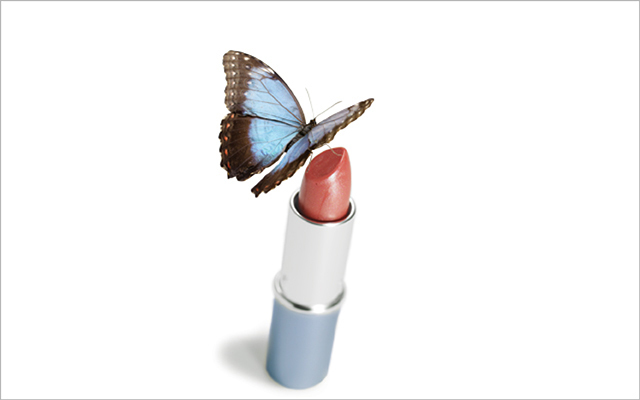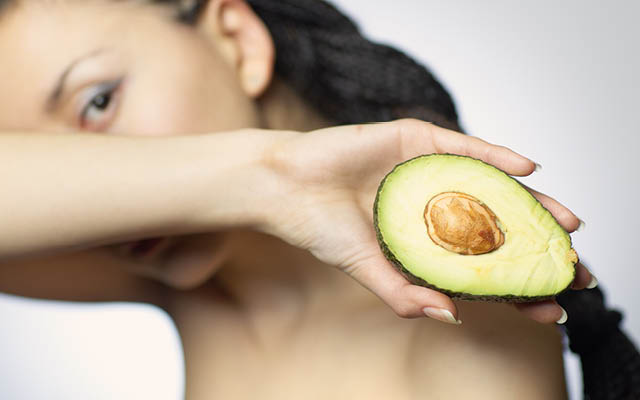Use these shortcuts to learn more about the chemicals in your beauty products:
Why Skin Matters | Fragrance | Parabens | Phthalates | P-Phenylenediamine | Toluene | Ethanolamines | A Safer-Product Protocol | Make Your Own
Tricia Pingel, NMD, a naturopathic doctor in Arizona, was surprised and frightened when her mother was diagnosed with non-Hodgkin lymphoma. Thankfully, she says, her mother managed to live 13 more healthy years before requiring chemotherapy and eventually passing away.
As a daughter and as a physician, Pingel was interested in how her mother’s genetics may have contributed to her illness. After her mother died, Pingel investigated her genetic profile, and she learned that her mother didn’t have the ability to break down benzene.
This meant something to Pingel. “The cancer that she had was 100 percent due to environmental exposure,” she explains. “She lived a healthy lifestyle. But the one thing that she did every month from the time she was in her 20s until the time of her death was dye her hair. And one of the main components of hair dye is benzene.”
Most mainstream personal-care products — and even many so-called clean ones — contain ingredients that can disrupt hormones, affect fertility, and contribute to cancer risk as well as a host of other health problems. Because the U.S. Food and Drug Administration (FDA) has little to no regulatory power over what goes into these products, inclusion of potentially dangerous ingredients in cosmetics and personal-care products has gone unchecked for years.
That’s changing. Consumers are educating themselves and demanding that companies disclose — and in some cases change — what’s in their products. This is crucial, Pingel says.
“We may not have complete control over the chemicals in the air we breathe or in some of the foods we eat, but we have 100 percent control over what we put on our skin.”
Why Skin Matters
Our skin is one of our largest and most vulnerable organs. “Skin is our barrier to the outside world, and it’s very permeable,” says wellness expert Cindi Lockhart, RDN, LD. “When we eat or drink something, it gets processed through the liver to determine if we’re going to detoxify it or absorb and use it.” But skin doesn’t have this set of defenses. “When something is applied to your skin, it can be absorbed directly into your bloodstream.”
There are also stages of development in which we’re more vulnerable to the toxic effects of harmful chemicals. These include periods of rapid growth and development, such as in utero, infancy, puberty, and pregnancy.
Yet in the United States, there’s almost no oversight of the chemicals used in personal-care products. This is different from the European Union, where premarket safety assessments and mandatory registration of cosmetic products are required by law. Many multinational companies even create separate formulations to sell in Europe, while their U.S. products continue to contain unsafe ingredients.
“Cosmetic products — legally defined as both beauty products and personal-care products — are one of the least regulated consumer products in the United States today,” says Janet Nudelman, cofounder and director of the Campaign for Safe Cosmetics coalition, a project of Breast Cancer Prevention Partners. “The $100 billion cosmetics industry is regulated by only two pages of federal law, and that was enacted in 1938.” Since 1938, those two pages have been amended only a handful of times.
More than 1,300 ingredients have been banned from personal-care products in Europe. In the United States, just 11 are barred or restricted.
One reason for this discrepancy is a hindered FDA. Most people wrongly assume that the FDA has the same oversight powers with personal-care products as it does over food and medications, but there’s no real parallel, thanks in part to a powerful industry lobby.
A vivid example of the FDA’s limitations occurred with the company Brazilian Blowout, which marketed its hair-straightening products as formaldehyde-free. “Formaldehyde is a known human carcinogen,” Nudelman says, “and this product was making hairdressers sick, because it was releasing formaldehyde when the product was heated, which is how the application takes place.”
“So here you have a product being marketed as formaldehyde-free and containing more formaldehyde than an undertaker uses to embalm a dead person.”
When the product was tested, it was found to contain more than 10 percent formaldehyde. “So here you have a product being marketed as formaldehyde-free and containing more formaldehyde than an undertaker uses to embalm a dead person.”
The FDA wrote Brazilian Blowout, asking it to voluntarily recall its products and change the formulation to make it safer. “The company basically laughed at them and said, ‘We’re not going to, and there’s nothing you can do to make us.’”
It took the California attorney general (Kamala Harris at the time) suing the company to finally compel Brazilian Blowout to change its marketing claims — though she still couldn’t force the company to change the formulation itself.
Yet even this power differential is changing. Some states, tired of waiting for Congress to grant the FDA more regulatory power, are enacting laws of their own. In 2020 California governor Gavin Newsom signed the Toxic-Free Cosmetics Act, which bans 24 ingredients and is “aimed at chemicals often linked to cancer, reproductive harm, birth defects, and endocrine disruption.” (The law won’t go into effect until 2025.)
Consumer advocacy groups, such as the Campaign for Safe Cosmetics, have also had an impact. By highlighting the fact that multinational corporations are able — when forced — to make safer products in Europe, the group successfully convinced major players within the nail-polish industry to stop using what’s referred to as the “toxic trio” (dibutyl phthalate, toluene, and formaldehyde). “These three chemicals are linked to reproductive harm and cancer,” Nudelman says. “So that was a big win.”
Predictably, given this rising awareness, some companies now use greenwashing tactics to appear safer. Buyers must beware: There are no regulations about calling something safe or using words like “natural” and “organic.” These two standards apply only to agricultural products.
This is no reason to give up the search — and it may be easier than it’s ever been to find safe personal-care products. Armed with some information, patience for reading ingredient lists, and resources to use when you’re in a hurry, you’ll be able to clean up your cosmetics and find new ones that you enjoy using. To start, know that these are the most important ingredients to avoid.
Fragrance
This may be the trickiest word on a product-ingredient list. Because fragrances are considered trade secrets, companies don’t have to disclose what’s in them. And fragrance is found in the majority of personal-care products, including those intended for babies. Even “unscented” products can contain fragrance to mask other scents.
The International Fragrance Association lists 3,059 materials reported as being used in fragrance compounds, including phthalates and other endocrine disrupters. Evidence links some of these to allergies, cancer, reproductive toxicity, and other health issues.
Because fragrances are considered trade secrets, companies don’t have to disclose what’s in them.
But seeing “fragrance” on an ingredient label also presents an opportunity. Lisa Fennessy, founder of the clean-beauty website The New Knew, says that instead of putting a product back on a shelf if the word “fragrance” appears in its ingredient list, sometimes she picks up the phone or sends an email with a question.
Calling the company to ask what’s in its fragrance does two things, she says: “It gives you the personal knowledge to make an informed decision, and it alerts the company that their buyers have a stake in what’s in their fragrance.”
Finally, if the product is free of most other toxic ingredients, give it a whiff. A synthetic fragrance will hit you like a brick wall. An essential-oil-based fragrance will likely be more subtle. Trust your nose. (For more on scents and health, see “The Problem With Perfume“.)
Parabens
A group of preservatives that prevent the growth of microbes, such as yeasts, molds, and bacteria, parabens can be found in just about every type of personal-care product: deodorant, shampoo, conditioner, lotion, sunscreen. Five parabens have been banned in Europe: isopropylparaben, isobutylparaben, phenylparaben, benzylparaben, and pentylparaben. Others are strictly regulated.
Again, they’re not regulated in the United States. The FDA’s website states, “At this time, we do not have information showing that parabens as they are used in cosmetics have an effect on human health.”
If we were exposed to parabens only occasionally,the body might be able to detoxify them. But because they’re ubiquitous, their cumulative effects add quickly to the body’s toxic burden.
The Environmental Working Group (EWG), a nonprofit environmental research and advocacy organization, disagrees. Citing studies that have connected parabens to reproductive harm, it notes: “Parabens can act like the hormone estrogen in the body and disrupt the normal function of hormone systems, affecting male and female reproductive-system functioning, reproductive development, fertility, and birth outcomes.”
If we were exposed to parabens only occasionally, the body might be able to detoxify them. But because they’re ubiquitous — and often found in products that are used daily — their cumulative effects add quickly to the body’s toxic burden, or the sum total of chemicals stored in fat cells.
As for less harmful preservatives, there are many. Dana Jasper, manager of renowned clean-beauty store Merz Apothecary in Chicago, says that some companies are using plant-based alcohols as alternatives to parabens. “Witch hazel is really good, too,” she says, “and it has a naturally antibacterial property to it.”
Phthalates
Known as “the everywhere chemical,” phthalates are used in a wide range of products, including plastics, solvents, and personal-care products. If an ingredient label lists “fragrance,” phthalates likely lurk inside: They’re often found in nail polish, hair gel, deodorant, soap, and body lotion, because they help fragrances linger longer. They also make formulations stick to the skin better, explains Lockhart.
Phthalates are endocrine disrupters, which means they can contribute to infertility, hormone imbalances, and birth defects. According to the nonprofit Zero Breast Cancer, “Children under the age of 3 are more at risk from phthalates because of their developing, smaller body size and ever-present exposure to children’s products manufactured using multiple types of phthalate compounds.”
Phthalates are endocrine disrupters, which means they can contribute to infertility, hormone imbalances, and birth defects.
Black consumers may also be more vulnerable to phthalate exposure. A recent study from the Silent Spring Institute found that hair-care products marketed to Black women contain higher percentages of endocrine-disrupting chemicals, including phthalates, than those marketed to the general public.
The study looked at 18 hair products marketed to Black women, including hot-oil treatments, anti-frizz hair polishes, leave-in conditioners, root stimulators, and hair relaxers. Forty-five endocrine disruptors were detected in the products, and 84 percent of the chemicals detected were not on the product label.
Several types of phthalates are banned or restricted in the European Union. In the United States, two types — dibutyl phthalate and diethylhexyl phthalate — will be banned in California beginning in 2025 as part of the Toxic-Free Cosmetics Act.
On labels, look out for phthalate, diethyl phthalate (DEP), dibutyl phthalate (DBP), diethylhexyl phthalate (DEHP), and fragrance. Choose nail products with labels that say “phthalate-free.”
P-Phenylenediamine
Derived from coal tar, p-phenylenediamine (PPD) is mixed with other chemicals to create darker shades of hair dye. (It’s also used in printing, as well as oil, gas, and rubber products.) According to the Campaign for Safe Cosmetics, “p-phenylenediamine, as well as the products of its reactions with hydrogen, can alter the genetic material of cells.”
It is also suspected of being carcinogenic and therefore is banned in Europe.
Look for it on ingredient lists as follows:
- P-phenylenediamine (PPD)
- Paraphenylenediamine
- 4-aminoaniline
- 1,4-benzenediamine
- P-diaminobenzene
- 1,4-diaminobenzene
- 1,4-phenylenediamine
Toluene
Another harmful chemical found in hair dye, toluene is also used in nail treatments and polishes to suspend the polish and create a smooth finish.
Restricted in Europe, toluene is listed as a hazardous air pollutant by the Environmental Protection Agency (EPA), yet it is still legal in the United States. After pressure, some companies have removed toluene, along with dibutyl phthalate (DBP) and formaldehyde, from nail polishes.
Salon workers are particularly susceptible to toluene’s harmful effects because it’s inhaled as well as absorbed through the skin. The fumes can irritate the throat, eyes, mouth, and skin, and they can cause headaches, dizziness, confusion, and anxiety.
Long-term exposure may lead to fatigue, slow reaction, difficulty sleeping, numbness in the hands or feet, reproductive-system damage, and miscarriage.
Ethanolamines
This family of chemicals includes monoethanolamine (MEA), diethanolamine (DEA), and tri-ethanolamine (TEA). They are used as surfactants to help a product become sudsy and as emulsifiers to prevent ingredients from separating. They are found in soaps and shampoos, hair dyes, cosmetics, fragrances, and sunscreens.
Research suggests that DEA may alter sperm structure. It can also accumulate in the liver and kidneys, potentially triggering organ toxicity and neurotoxic effects such as tremors. Another study suggests that DEA can negatively affect fetal brain development. It may also have carcinogenic effects.
DEA is prohibited in Europe. In the United States, avoid products containing TEA, DEA, cocamide DEA, cocamide MEA, DEA-cetyl phosphate, DEA oleth-3 phosphate, lauramide DEA, and TEA-lauryl sulfate.
This ether is prevalent in products that create suds — think shampoo, liquid soap, bubble bath — and in hair relaxers. Not an ingredient itself, 1,4-dioxane is created during ethoxylation, in which ethylene oxide is added to other chemicals to make them less harsh, according to the Campaign for Safe Cosmetics.
The EPA has classified 1,4-dioxane as “likely to be carcinogenic to humans” by all routes of exposure, and it is banned in Canada and Qatar as well as restricted in New York state. Yet the Campaign for Safe Cosmetics says it “may be found in as many as 22 percent of the more than 25,000 cosmetics products in the Skin Deep database.”
Because it’s technically a manufacturing byproduct, according to the FDA, 1,4-dioxane doesn’t appear on labels by name. It hides under the names laureth-23, sodium lauryl sulfate (SLS), or polyethylene glycol (PEG) compounds.
Because of 1,4-dioxane, DEA, and other toxic chemicals used as surfactants, Pingel advises her patients to be wary of products that are sudsy. “People think if a product is sudsy, they’re getting clean, but that’s actually not true. If it foams up, we’ve got a problem.”
A Safer-Product Protocol
Once you decide to clean up your personal-care routine, it may be tempting to toss everything and start fresh. This approach may be exactly right for some people, but it’s not the only way. Some experts suggest replacing products as they run out, which gives you a little time to research and find safer brands or formulations that you like.
As for order of importance, Fennessy suggests paying close attention to what stays on your body the longest and making sure the products you use most frequently are as nontoxic as possible. (And don’t leave out items that you use seasonally, like sunscreen.) The good news is that resources abound for finding cleaner cosmetics, as well as for researching your current favorites. These tools and resources will get you started.
To evaluate product safety:
The EWG maintains the Skin Deep database, which takes the stress out of finding clean products and checking on formulations you already have. Made Safe, Ecocert, and Cosmos are third-party certifiers that research and vouch for the safety of particular products.
To find and purchase cleaner products:
Retailers such as Beautycounter, Credo, and the Detox Market sell only products that meet their standards for safety. Their websites offer very clear information about their safety policies and ingredients.
Tools to use in the product aisle:
The Yuka and Think Dirty apps allow you to scan a product’s barcode for a quick look at its safety score. When you’re perusing products online, try Clearya, a Chrome extension that checks ingredient labels as you shop.
Make Your Own
Some people opt out of the guessing game altogether and make their products themselves. If that sounds appealing, try out these recipes for eight products you can make at home, including beet lip gloss and a chocolate facial mask at “DIY Beauty“.
Learn how to make your own facial oil at “DIY Beauty: Cypress Firming Facial Oil“.
This article originally appeared as “Know Your Beauty” in the December 2021 issue of Experience Life.





This Post Has 4 Comments
[…] landfills and polluting oceans. But it’s also bad for our personal health. Growing evidence links phthalates — chemicals used to soften and form plastics — to a wide variety of adverse conditions, […]
[…] landfills and polluting oceans. But it’s also bad for our personal health. Growing evidence links phthalates — chemicals used to soften and form plastics — to a wide variety of adverse conditions, […]
[…] landfills and polluting oceans. But it’s also bad for our personal health. Growing evidence links phthalates — chemicals used to soften and form plastics — to a wide variety of adverse conditions, […]
[…] landfills and polluting oceans. But it’s also bad for our personal health. Growing evidence links phthalates — chemicals used to soften and form plastics — to a wide variety of adverse conditions, […]